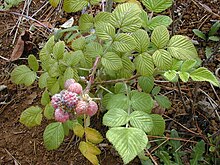Rubus niveus
| Rubus niveus | |
|---|---|

| |
| Scientific classification | |
| Kingdom: | Plantae |
| Clade: | Tracheophytes |
| Clade: | Angiosperms |
| Clade: | Eudicots |
| Clade: | Rosids |
| Order: | Rosales |
| Family: | Rosaceae |
| Genus: | Rubus |
| Species: | R. niveus
|
| Binomial name | |
| Rubus niveus Thunb. 1813 not Wall. ex G. Don 1832
| |
| Synonyms[1] | |
|
Synonymy
| |
Rubus niveus (Mysore raspberry,[2] Ceylon raspberry,[2] hill raspberry;[2] Chinese: 红泡刺藤, Hindi: काला हिसालू, romanized: kala hinsalu) is a species of Rubus native to southern Asia, from Afghanistan east through India and China to Taiwan and the Philippines, south to Sri Lanka and Malaysia, and north to Gansu in China.[3][4][5]
Description[]
Rubus niveus is a shrub growing to 1–2.5 m tall, the stems whitish tomentose at first, becoming glabrous green to purple later. The leaves are pinnate with 5–11 leaflets (mostly 7 or 9), the leaflets 2.5–8 cm long and 1–4 cm broad, dark green above, densely pale grey to white tomentose beneath. The flowers are about 1 cm diameter, with five dark pink to red petals. The fruit is 8–12 mm diameter, densely grey tomentose, dark red at first, ripening black.[3]
Cultivation[]
Rubus niveus is cultivated for its edible fruit. It has become naturalised and invasive in Hawaii and the Galápagos Islands.[6]
References[]
- ^ The Plant List, Rubus niveus Thunb.
- ^ a b c "Rubus niveus". Germplasm Resources Information Network (GRIN). Agricultural Research Service (ARS), United States Department of Agriculture (USDA). Retrieved 2 January 2018.
- ^ a b Flora of China: Rubus niveus
- ^ "Rubus niveus". Plants for a Future.
- ^ University of Melbourne: Sorting Rubus names
- ^ Pacific Island Ecosystems at Risk: Rubus niveus
![]() Media related to Rubus niveus at Wikimedia Commons
Media related to Rubus niveus at Wikimedia Commons
- Rubus
- Flora of Asia
- Plants described in 1813
- Berries
- Rubus stubs